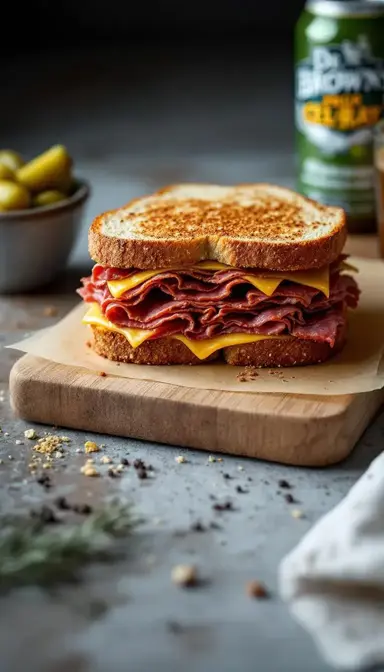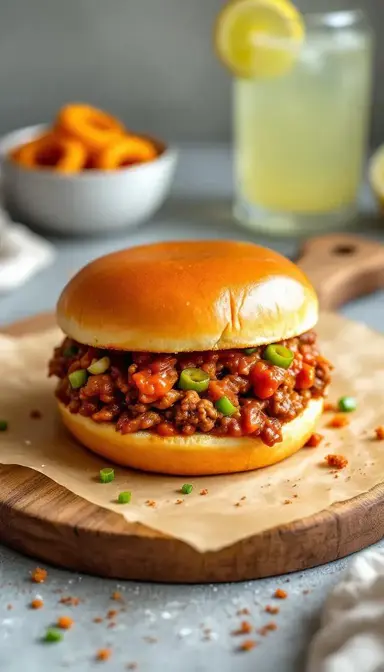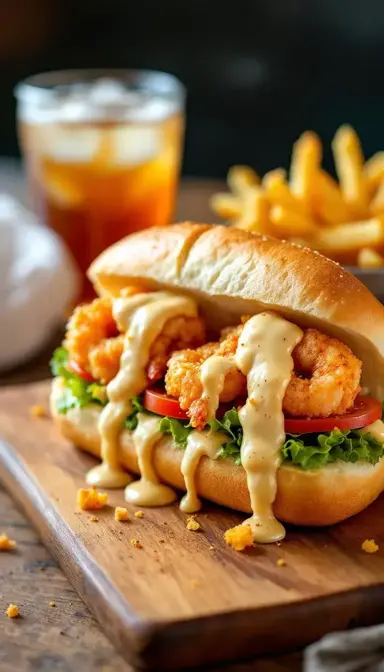There’s something almost sacred about a perfectly stacked Pastrami on Rye. The moment you take that first bite—tender, spice-crusted pastrami melting against the tangy bite of mustard, all hugged by that hearty, slightly sour rye bread—it’s like stepping into a New York deli, no matter where you are. This isn’t just a sandwich; it’s a masterpiece of flavor and texture, a testament to the magic that happens when simple ingredients are treated with care and respect.
Why This Recipe Works
- Flavor That Packs a Punch – That deep, smoky, peppery crust on the pastrami? It’s not just seasoning—it’s a labor of love, a slow dance of spices and time that transforms humble brisket into something extraordinary.
- Texture Heaven – The crunch of toasted rye, the juicy give of the pastrami, the creamy sharpness of mustard—it’s a symphony in every bite.
- Endless Possibilities – Keep it classic with Swiss and sauerkraut, or go wild with pickles, Russian dressing, or even a fried egg. This sandwich is your canvas.
The Story Behind the Sauce
This isn’t just food—it’s a story. Born in the Jewish delis of late 19th-century New York, Pastrami on Rye was a way to preserve brisket through curing and smoking, then serve it up on rye bread, a staple of Eastern European kitchens. It’s a sandwich with roots, with soul, and every bite carries that legacy.
Essential Ingredients & Tools
Ingredients for the Pastrami
- 3 lbs beef brisket (flat cut, fat cap intact) – The star of the show. That fat cap isn’t just for flavor—it’s your insurance against dryness.
- ¼ cup coarse kosher salt – The foundation of your cure. Don’t skimp.
- 2 tbsp black peppercorns, coarsely cracked – For that signature peppery bite.
- 2 tbsp coriander seeds, lightly crushed – Warm, citrusy, and absolutely essential.
- 1 tbsp smoked paprika – A whisper of smoke, even if you’re not smoking the meat.
- 4 garlic cloves, minced – Because what’s life without garlic?
- 1 tbsp brown sugar – Just a touch to balance the salt and spice.
Ingredients for the Sandwich
- 8 slices traditional rye bread – Seeded or unseeded, your call. But make sure it’s good rye—no flimsy imposters.
- ½ cup spicy brown mustard – The tangy counterpoint to all that rich meat.
- ½ lb Swiss cheese, thinly sliced (optional) – If you’re feeling indulgent.
- 1 cup sauerkraut or dill pickle slices – For that classic deli crunch and zing.
Tools You’ll Need
- Large mixing bowl – For curing the brisket.
- Dutch oven or heavy-bottomed pot with lid – Low and slow cooking is key. No Dutch oven? A deep roasting pan covered tightly with foil works.
- Meat thermometer – Essential for hitting the perfect internal temperature.
- Sharp slicing knife – A chef’s knife or bread knife will do in a pinch.
Serves: 4 | Prep: 30 mins (plus 5 days curing) | Cook: 6 hours | Total: 6 hours 30 mins
How to Make Pastrami on Rye
- Cure the Brisket
Mix the ¼ cup coarse kosher salt, 1 tbsp brown sugar, and half the 4 garlic cloves, minced into a paste. Rub it into every nook and cranny of that 3 lbs beef brisket like you’re giving it a spa treatment. Wrap it tight in plastic (double-layer to avoid leaks) and let it chill in the fridge for 5 days, flipping it daily. This isn’t just waiting—it’s transforming. Pro tip: Put it on a rimmed baking sheet. Trust me, you don’t want a fridge full of brisket juice. - Rinse and Dry
After its salt bath, rinse the brisket under cold water to wash away the excess salt. Pat it dry like you’re tucking it in for bed—any moisture left will keep the spice rub from sticking. Let it air-dry on a rack for 10 minutes while you mix up the rub. - Spice It Up
Crack the 2 tbsp black peppercorns, crush the 2 tbsp coriander seeds, and mix them with 1 tbsp smoked paprika and the rest of the 4 garlic cloves, minced. Press the blend onto the brisket like you’re sealing a promise. Let it sit at room temp for an hour—this lets the spices get cozy with the meat. Chef’s secret: A light mist of water before rubbing helps the spices cling like a second skin. - Slow Cook to Glory
Heat your oven to 300°F (150°C). Nestle the brisket into a Dutch oven with 2 cups of water or beef broth (broth adds depth). Cover it tight—this is a steam bath, not a sauna. Let it cook for 5–6 hours, until it hits 200°F (93°C) internally. Test it with a fork—it should slide in like butter. - Rest and Slice
Move the pastrami to a cutting board and tent it with foil. Let it rest for 20 minutes—this is when the juices settle back in. For deli-thin slices, pop it in the fridge for an hour first. Slice against the grain at a 45° angle. Pro tip: Freeze it for 30 minutes before slicing for cleaner cuts. - Build the Sandwich
Toast the 8 slices traditional rye bread—just enough to wake up its nutty flavor. Slather on the ½ cup spicy brown mustard (both slices, no cheating). Pile on the warm pastrami (reheat slices in broth if needed), ½ lb Swiss cheese if you’re using it, and a heap of 1 cup sauerkraut or dill pickle slices. Press it gently, like you’re hugging it together, then slice diagonally—because sandwiches taste better when they’re cut on an angle.
Pro Technique
- The Steam Trick
Wrap the cooked pastrami in foil and let it hang out in a 170°F (77°C) oven for 1 hour. This gentle steam relaxes the meat, making it even more tender and juicy. Bonus: Add a splash of broth to the foil for extra moisture. - Cold-Smoking for Depth
Before cooking, cold-smoke the cured brisket for 2 hours at 90°F (32°C) with applewood chips. It’s not traditional, but it adds a whisper of smoke that’ll make you feel like you’re in Katz’s Deli. Just keep the temp low—you’re flavoring, not cooking.
Chef’s Wisdom
- Salt is Your Friend (But Rinse It Off)
That rinse after curing isn’t optional. Skip it, and your sandwich will taste like the Dead Sea. For a milder cure, cut the salt by 1 tbsp and cure for 4 days instead of 5. Always fry up a tiny test slice to check the seasoning. - Slice It Right
Pastrami’s magic is in thin, even slices—no thicker than 1/8 inch. Thick cuts turn chewy and overpower the sandwich. Use a sharp knife and always cut against the grain—it’s the difference between tender and tough. - Mustard Matters
Spicy brown mustard is the classic for a reason—its vinegar tang cuts through the pastrami’s richness. Honey mustard or mayo? Save those for lesser sandwiches. For extra kick, mix in a dash of horseradish.
Storage & Freshness Guide
- Cooked Pastrami
Store it in an airtight container with a splash of broth for up to 5 days. To reheat, simmer slices in broth for 2 minutes—it’s like a spa day for your meat. Freeze between parchment paper layers for up to 3 months; thaw in the fridge overnight. - Bread and Fixings
Rye bread dries out fast. Keep it in a bread box or freeze slices, toasting them straight from frozen. Sauerkraut and pickles last for weeks in their brine—just drain well before using. - Assembled Sandwiches
Eat them fresh. If you must prep ahead, keep components separate and assemble just before eating to avoid sogginess. Wrap in parchment paper for lunch—it breathes better than plastic.
Nutrition Profile
| Nutrient | Amount per serving |
|---|---|
| Calories | 620 |
| Protein | 42g |
| Carbohydrates | 35g |
| Fat | 34g |
| Fiber | 4g |
Ingredient Variations and Their Impact
- Marbled Rye Bread
Swap traditional rye for marbled rye (swirled with pumpernickel). It’s sweeter, prettier, and toasts up like a dream. - Smoked Turkey Pastrami
Use turkey breast instead of brisket for a leaner option. Brine it for 48 hours and add olive oil to the rub to keep it moist. - Emmental Cheese
Swap Swiss for Emmental—it’s nuttier, fruitier, and melts like a dream. Pair it with caramelized onions for a gourmet twist. - Russian Dressing
Replace mustard with Russian dressing (mayo, ketchup, horseradish). It’s creamy, tangy, and Reuben-approved. Add smoked paprika for depth. - Gluten-Free Bread
Use seeded gluten-free bread. Toast it twice and brush with caraway-infused water to mimic rye’s chew.
Perfect Pairings
Complementary Dishes
- Half-Sour Pickles
Their bright crunch and tang cut through the richness. Serve with a side of pickle brine for dipping—trust me. - Creamy Coleslaw
Go for a Vinegar-Based Slaw (no mayo) to keep it light and refreshing.
Drinks
- Dr. Brown’s Cel-Ray Soda
A deli classic—celery-flavored soda sounds weird until you try it with pastrami. - Malty Brown Ale
The caramel sweetness complements the smoke, and the carbonation lifts the fat.
Something Sweet
- Black-and-White Cookie
A NYC staple—sweet, cakey, and the perfect finish. - Cinnamon Rugelach
Flaky, jam-filled, and deeply comforting. Warm them slightly for extra magic.
FAQs
- Can I shortcut the curing process?
No. The 5-day cure is non-negotiable for flavor and texture. Quick “pastrami” is sad pastrami. - Why is my pastrami tough?
It didn’t cook long enough. Brisket needs to hit 200°F to break down collagen. If you’re short on time, use a pressure cooker (90 minutes on high). - What’s the best way to slice pastrami?
Chill it for an hour, then use a sharp knife or mandoline for paper-thin slices. Always cut against the grain.

Pastrami on Rye
Make the ultimate Pastrami on Rye at home with my step-by-step guide. Tender, slow-cooked pastrami meets tangy mustard and hearty rye. Get the recipe now!
Ingredients
For the Pastrami
-
3 lbs beef brisket (flat cut, fat cap intact)
-
¼ cup coarse kosher salt
-
2 tbsp black peppercorns (coarsely cracked)
-
2 tbsp coriander seeds (lightly crushed)
-
1 tbsp smoked paprika
-
4 cloves garlic (minced)
-
1 tbsp brown sugar
For the Sandwich
-
8 slices traditional rye bread
-
½ cup spicy brown mustard
-
½ lb Swiss cheese (thinly sliced (optional))
-
1 cup sauerkraut or dill pickle slices
Instructions
-
Cure the brisket by rubbing with ¼ cup coarse kosher salt, 1 tbsp brown sugar, and half the 4 garlic cloves, minced. Wrap tightly and refrigerate for 5 days, flipping daily.01
-
Rinse the brisket under cold water and pat dry.02
-
Apply spice rub (2 tbsp black peppercorns, 2 tbsp coriander seeds, 1 tbsp smoked paprika, remaining garlic) and let sit at room temp for 1 hour.03
-
Slow cook in a Dutch oven with 2 cups water or broth at 300°F for 5–6 hours until internal temp reaches 200°F.04
-
Rest the pastrami for 20 minutes, then slice thinly against the grain.05
-
Assemble sandwiches with toasted 8 slices rye bread, ½ cup spicy brown mustard, pastrami, ½ lb Swiss cheese (optional), and 1 cup sauerkraut or dill pickle slices.06



